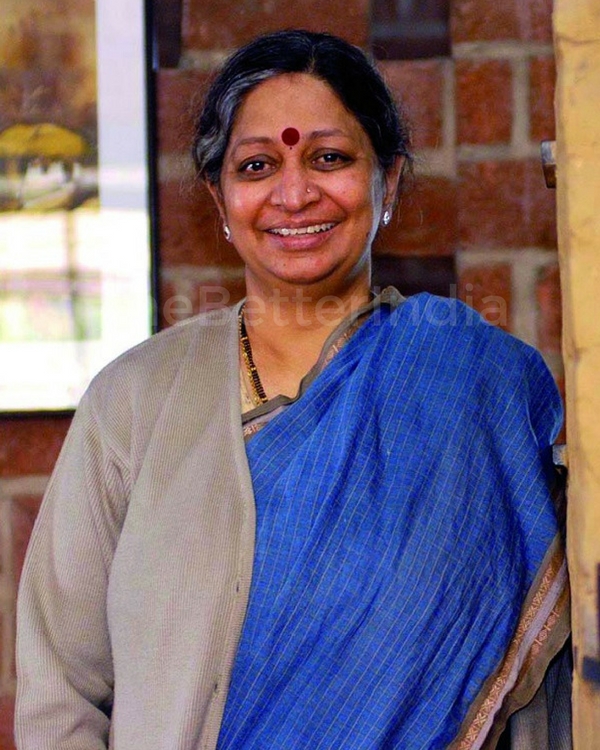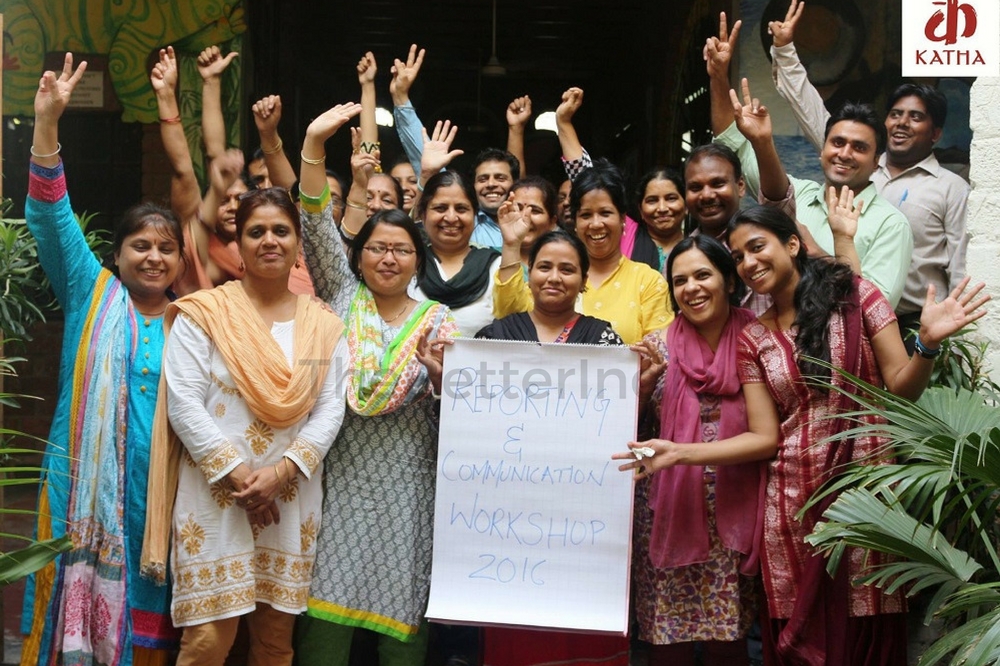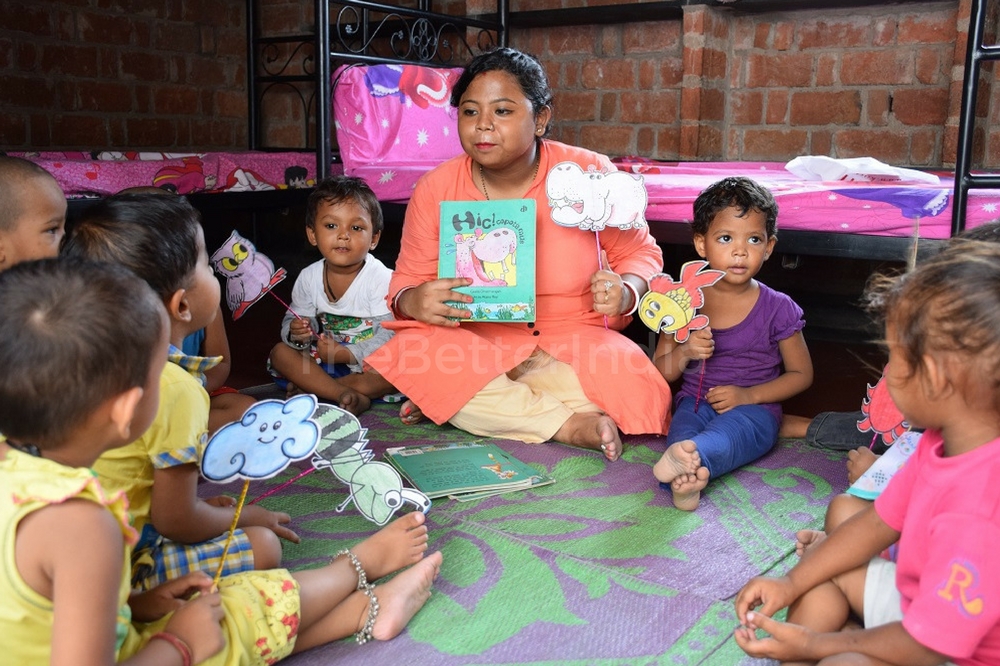How Thousands of Children in Indian Slums Are Learning through Colourful Storybooks
Katha, an NGO based in Delhi, has been educating kids in slums and publishing books for them since 1988.

Katha, an NGO based in Delhi, has been educating kids in slums and publishing books for them since 1988.
“I have loved stories since childhood,” says Geeta Dharmarajan, children’s writer, editor, social worker, and Padma Shri awardee.
And stories are exactly what this 68-year-old has used to shape and transform the lives of thousands of children living in slums across India.

Geeta founded Katha about 28 years ago to educate children living in Delhi slums and to enable their mothers to send them to schools. Although it started as a one-woman organization, Katha now runs schools for underprivileged children in 252 slums in Delhi, Arunachal Pradesh, Haryana, and Maharashtra. The NGO also publishes story books for children in 21 Indian languages to inculcate the habit of reading among its students, provides vocational training to women and helps them gain employment, and trains government school teachers to teach more effectively.
Geeta’s remarkable journey began in 1986 when she and her family returned to India after spending a few years in the US. They settled in Tamil Nadu and she started working with an orphanage. After a couple of years, when her husband was transferred to Delhi , Geeta moved with him, hoping she would still get a chance to continue working with children.
“I came to Delhi thinking that kids here would at least be reading and going to schools like I had seen in most areas of Tamil Nadu. Instead, I found children who knew less Hindi than I did, who were not going to school, and who seemed to have no dreams for their future. In the slums of Govindpuri, I saw children as young as four years old folding envelopes to earn a living. The sight first disturbed me, then frustrated me, and finally, I was outraged enough to do something about the situation,” she says.
You may also like: This Duo Converted Boring Textbooks into Fun Videos and Animation for School Kids in Gujarat
Tamasha: The beginning

In 1988, Geeta started a magazine for children called Tamasha. The focus of Tamasha was to take literacy to students living in underprivileged communities with the help of stories, colourful illustrations, and engaging activities. It carried stories on health, environment, women’s empowerment, and more. When the then commissioner of the slum wing of Delhi Development Authority came across the magazine, he worked with the government to increase its circulation to different slums across the city. In the ten years that it was published, 17 issues of Tamasha reached about 30,000 schools.
Katha schools: For kids and their parents

Katha was formally registered as an NGO in the year 1989. By this time, some like-minded friends joined Geeta to volunteer and help. In the same year, she started Katha Shala, the organization’s first school. It began with five students. It was this school that led to the development of Katha’s story pedagogy – the technique of using story books, along with school textbooks, to increase children’s confidence and raise their social consciousness. The teachers for the school came from the slums too and they were trained by Katha.
However, Geeta soon realised that most parents would not send their children to school because they could not afford to. “I thought if I am able to help women in the slums earn a sum of Rs. 800-1,000 every month, they will send their kids to schools. So, in December 1990, Katha started a programme to train women in income-generating activities like cooking, bakery, embroidery, and teacher training,” she says. Today, there are 43 Katha Lab Schools in Delhi , with 45,000 students, supported by 2,000 volunteers from the slums. Additionally, over 20,000 women have helped increase their family incomes ten-fold with the help of skills they learned at Katha.
You may also like: A ‘Spark’ of Brilliance: IIT-Mandi Students’ Initiative to Provide Quality Education to Rural Kids
Katha publications: To make reading fun

Geeta developed an interest in translating when she started reading stories from different states across India.
“One thing I was sure of was that it is necessary to look at language, culture and translations when teaching kids. Other than teaching them about environmental sustainability, science, and math, we also have to teach them about our cultural backgrounds,” says Geeta. With this in mind, she started translating books from Tamil to English and Hindi.
As a result of her efforts, Katha soon became a publisher of children’s books as well. Katha books have simple stories, accompanied with beautiful illustrations, for children aged two and above. All books are available in Hindi and English. Today, Geeta has a team of 600 freelance writers and translators. Katha has over 400 published titles that have been read by over 80,00,000 children to date.
Geeta’s book, Moon, Ramu and I, won the Darsana National Award for Best Children’s Book in 2011. In 2012, she received the Padma Shri for “education and literature”.
For street children: The Tamasha road show
In 2001, Geeta started the Tamasha Road Show – a learning programme to educate street children aged 5-17. A colourful van takes the ‘Katha School on Wheels’ to 10 traffic intersections in South Delhi every day, and teaches over 1,000 street children using fun learning materials, books, puppets, and a computer. Recently, the Delhi government also invited Katha to work in government schools to help bring children to their grade reading levels using the Katha pedagogy of teaching with stories along with NCERT books
In pursuit of a brighter future:

Today, many Katha students have joined mainstream colleges and several are doctors, engineers, and teachers. Geeta says 80% of Katha children get into college every year. “Gayatri is one such student. Her parents had to sell everything they had to ensure she received quality education and was able to prepare for a competitive exam. Today, she works in the customs department at Delhi airport,” she says. Similarly, Kamal joined Katha as a young boy and chose painting as his area of interest. Today, he holds exhibitions of his work and is also the head of the art department in an international school in Delhi.
Katha has helped over 900,000 children help themselves out of poverty, trained 21,500 of them in information technology, and taught 90,000 women income-generation skills. A journey of two decades has not dampened Geeta’s enthusiasm for providing a brighter future to the underprivileged children in Delhi slums.
“When I went into the slums and saw these children for the first time, it was almost as if they had no future or dreams. I remember asking a girl named Maya what she wanted to do when she grew up. She said she wants to go to her in-laws’ place. That was the only thing in her mind. But if you saw her eyes, you could see how active her mind really was. I just wanted to bring such kids into a space where they could respect what their minds were capable of doing,” concludes Geeta, reiterating the vision of her organization that no child should live in poverty – be it social, personal, intellectual, cultural or environmental.
Know more about Katha here.
You may also like: Parents in Rural AP Are Rating Their Kids’ Schools Using Mobile Phones. Schools Are Falling in Line!
Like this story? Or have something to share? Write to us: [email protected], or connect with us on Facebook and Twitter.
NEW: Click here to get positive news on WhatsApp!
This story made me
- 97
- 121
- 89
- 167
Tell Us More
We bring stories straight from the heart of India, to inspire millions and create a wave of impact. Our positive movement is growing bigger everyday, and we would love for you to join it.
Please contribute whatever you can, every little penny helps our team in bringing you more stories that support dreams and spread hope.



















